By Darragh O’Dwyer
The historic class confrontation sweeping Peru has entered its 7th week. On one side stands the Peruvian oligarchy and their loyal servants in the form of the deeply unpopular coup government. On the other, are the politically awakened workers, poor and indigenous people demanding the resignation of illegitimate president Dina Boluarte, the dissolution of congress, new elections and a constituent assembly to challenge the power of the corrupt elite.
Road blockades continue to paralyse much of the country. Machu Picchu is closed, causing a massive dent in Peru’s multi-billion dollar tourist industry. The economic interests of the imperialist powers that plunder Peru’s natural resources have also been dealt a blow. Las Bambas copper mine, held by Chinese company MMG, has shut operations since the start of the month. Multinational mining giant Glencore has faced major restrictions and closures. These two companies alone account for 2% of global copper output, a commodity whose price is expected to surge with China’s economic reopening.
The above illustrates the extent of the economic disruption caused by the mass movement, and why the Peruvian ruling class is determined to stamp it out. That has not been straightforward, however. While brutal state repression has claimed the lives of over 50 people, the revolt persists.
La Marcha de los 4 Suyos
January 19 marked a new phase, when thousands of protesters flocked to the capital for La Toma de Lima (The takeover of Lima). Videos show inspiring displays of solidarity as convoys from Puno, Ayacucho, Arequipa, Cusco and Apurímac collectively fundraised and set off on the long journey to the capital. These regions, some of the poorest in Peru with large indigenous populations of oppressed Aymara and Quechua speakers, have been the beating heart of the revolt. Unsurprisingly, they are also where the repression has been most ferocious, as evidenced in the massacres of Ayacucho and Juliaca. Neither of these bloodbaths received much media attention and, where they did, were often justified with racist tropes and accusations of terrorist involvement.
Centralising the movement in the capital and bringing it to the doorstep of the illegitimate coup government, was therefore an important strategy to deepen and extend the rebellion. The demonstration was also referred to as La Marcha de los 4 Suyos, a conscious nod to the mass mobilisation of the same name in 2000, which was key to bringing down the loathed Alberto Fujimori dictatorship. Despite the formal democratic transition after Fujimori’s fall, the economic and political pillars of the regime remained in place, ensuring the continuation of neoliberal policies, corruption and social misery. Events of the two decades since then have pushed significant sections of the Peruvian masses to draw this conclusion. As a popular slogan in today’s movement goes: “this democracy is not a democracy.”
Repression and the eaid of San Marcos University
Aware of the growth in the depth and scale of the movement, the coup government braced itself for a showdown, deploying an unprecedented 11,000 officers of the Peruvian National Police (PNP) on the streets of the capital. The crackdown continued with cops launching tear gas into crowds of protesters, while the oligarchy and its media mouthpieces continued to demonise protesters as terrorists. On top of the demos in Lima, protests, blockades and clashes with state forces carried on throughout the South.
One particularly shocking incident took place on January 21. The heavily armed PNP raided Lima’s San Marcos university, using a tank to smash through the entrance before dozens of police began detaining students and those protesters that had set up camp in the university grounds. 200 were arrested in a conscious tactic to punish the students who showed an instinctive solidarity with the oppressed workers and poor that had come to Lima.
Yet this move has backfired. The widely shared footage provoked horror at scenes that harked back to 1991, when the Fujimori dictatorship raided the very same university. Adding fuel to the flames of the revolt, the protests have continued in Lima for 5 consecutive days with more delegations making the journey from across the country. The CGTP union federation called another national mobilisation on January 24 with demands to end criminal repression, kick out the congress and hold a constituent assembly. This was also backed by student unions who are also calling for the removal of San Marcos rector, Jeri Ramón, for her collaboration with police in the raid.
Weak government of Crisis
Boluarte seemed to have grasped that the raid of San Marcos represented an overreach and offered an apology. But despite growing pressure on her to resign she continues to cling to power, blaming violent clashes on “radical groups with a political and economic agenda rooted in drug trafficking, illegal mining and smuggling.” Once again, Puno, the epicentre of the struggle, is in the crosshairs of the regime who have militarised the region and declared another curfew. 500 soldiers have been sent into break up blockades that have ground large tracts of the country to halt. In a press conference on January 24, Boluarte was indistinguishable from the far-right Fujimoristas she campaigned against as Castillo’s vice-president: “Puno is not Peru”, she remarked, in a racist justification for the intensified repression still to come.https://www.facebook.com/plugins/video.php?height=308&href=https%3A%2F%2Fwww.facebook.com%2Fliubomir.fernandezfernandez%2Fvideos%2F1222467608386520%2F&show_text=false&width=560&t=0
However, Boluarte’s reliance on divisive rhetoric and continued brutality of state forces are not a sign of strength, but weakness. Yet another minister, Sandra Belaunde, has resigned from the coup cabinet, bringing the total number up to 6. Adopting a “carrot and stick” approach, Boluarte called for a truce and, after earlier conceding that elections would be moved from 2026 to 2024, she now proposes moving them to the end of this year.
While some more far-sighted politicians have chosen to jump like rats from a sinking ship, the hardcore Fujimoristas in the right-wing-controlled Congress have descended to new depths of depravity. Ernesto Bustamante, of Fuerza Popular (Popular Force) called for the Peruvian Army to invade neighbouring Bolivia after president Luis Arce criticised the coup government.
New ‘Pink Tide’ leaders condemn coup
Arce has been joined by his counterparts across the region in denouncing Boluarte. Peru is the latest in a wave of revolts that have swept Latin America since 2019 as an unprecedented crisis of capitalism gives way to social convulsions and political crises. The mass radicalisation has also expressed itself in the election of new moderate left governments across the region, a so-called second ‘pink tide’ (in reference to the wave of Left governments elected amid revolutionary movements at the beginning of the 2000s)
Andres Manuel Lopez Obrador immediately denounced the coup and offered Castillo and his family asylum in Mexico. More recently, Obrador called on CELAC, which meets this week, to declare itself in favour of Castillo’s release. Xiomara Castro, president of Honduras, recognised Castillo as the legitimate president and condemned the state’s ‘aggression against the Peruvian people.’ Her husband, former president Manuel Zelaya, was himself deposed in a US-backed coup in 2009 after his (minor) shift to the left made him unpalatable to US imperialism and the Honduran ruling class. Boluarte criticised Gustavo Petro for ‘a new act of interference’ when the Colombian president called for the Organisation of American States to launch a human rights investigation into state violence against protesters. Finally, Chile’s Gabriel Boric chastised the repression, comparing it to past dictatorships in the Southern Cone.
Of course, extreme political polarisation and instability are not limited to Peru, and the same drama playing out today is also inherent in the situation in a number of Latin American countries. The Bolsonaristas’ failed coup-attempt in Brazil on January 8 is the most striking example. Across the region, the decay of capitalism, coupled with the failures of the left, has created the conditions for the far-right to grow. In the recent period, certain figures have made significant electoral breakthroughs relying on a reactionary social agenda and promising to restore ‘law and order.’ Javier Milei of the growing Libertad Avanza party (Liberty Advances) in Argentina referred to the 30,000 disappeared under the military junta as an exaggerated estimate. José Antonio Kast, who ran against Boric in Chile’s presidential elections, was open in his admiration of the Pinochet dictatorship, a regime in which his older brother served as a minister.
The often forceful condemnation coming from the new reformist presidents reflects an awareness that they too face similar dangers at home. Yet, like Castillo, they also lack a programme and strategy capable of channelling the energy of the masses in a successful struggle against the far-right and the crisis-ridden capitalist system from which they arise. Socialists, workers and young people desiring genuine social transformation — across the continent and beyond — should learn from Castillo’s failures and the disastrous outcome of a policy of negotiation with the right. An independent movement of the working class and oppressed must be built with a clear strategy to change society by revolutionary means — replacing the repressive capitalist constitutional regimes (often directly inherited from military dictatorships) with an alternative system of working class democracy, based on public ownership and democratic control over the continent’s rich resources and key sectors of the economy.
Kick out Boluarte, the coup-government & capitalism
Today, such lessons can be learned by those on the frontlines of the struggle in Peru. The determination and heroism displayed by these sectors of the exploited and oppressed cannot be doubted. There is an organic tendency towards unity as the logic of the class struggle pushes the most advanced layers to draw correct political conclusions. In some cases this has even led to the flourishing of rank-and-file committees of struggle that are playing an important role in coordinating action on a local and regional level.
These must continue to be strengthened and linked up across the country in order to bring down Boluarte and the illegitimate coup government. Such organisations would be best positioned to extend a class appeal to the lower ranks of the armed forces, in particular, the soldiers sent into Puno, who have more in common with those on the streets than the ruling class.
Arming itself with a socialist strategy and programme the movement could continue to draw into its ranks all layers of the oppressed masses — workers, peasants, indigenous people, women, students and LGBTQ activists — and continue to develop new organs of popular power to democratically organise the struggle including coordinated strikes, demonstrations, blockades and occupations.
The nominally Marxist Peru Libre — of which both Castillo and Boluarte were members — falls far short of the mass left party required to politically organise the working class, peasants and indigenous people in a struggle for a new society. Yet Peru’s Libre patent failure at building such a party does not make this historic task any less urgent. The outline of a mass revolutionary force, one under the democratic control of its rank-and-file activists, can be seen today as workers, youth, peasants and indigenous people, grope for new forms of organisation to advance their struggle.
Such a force would ensure that the popular demand for a Constituent Assembly is not converted into a farcical process of demobilising the movement and diverting it into safe institutional channels, as seen in neighbouring Chile. A Revolutionary Constituent Assembly, whereby delegates are directly elected and subject to recall by the organisations of struggle we see forming today, could chart a way out of the overlapping crises that Peru finds itself in today. This would require not only tearing up the 1993 Fujimorista constitution but fighting for a programme to nationalise the mining, manufacturing, transport and banking sectors under workers’ control and management as part of the battle to end the rule of capital once and for all.












